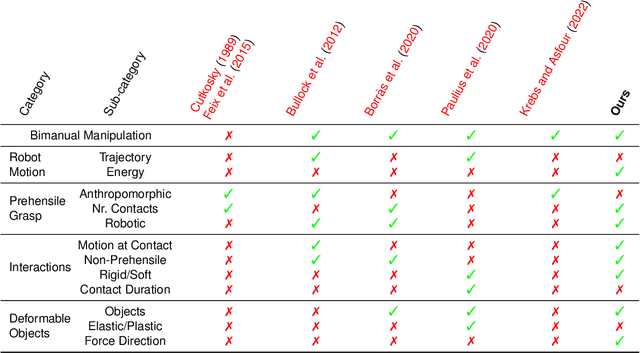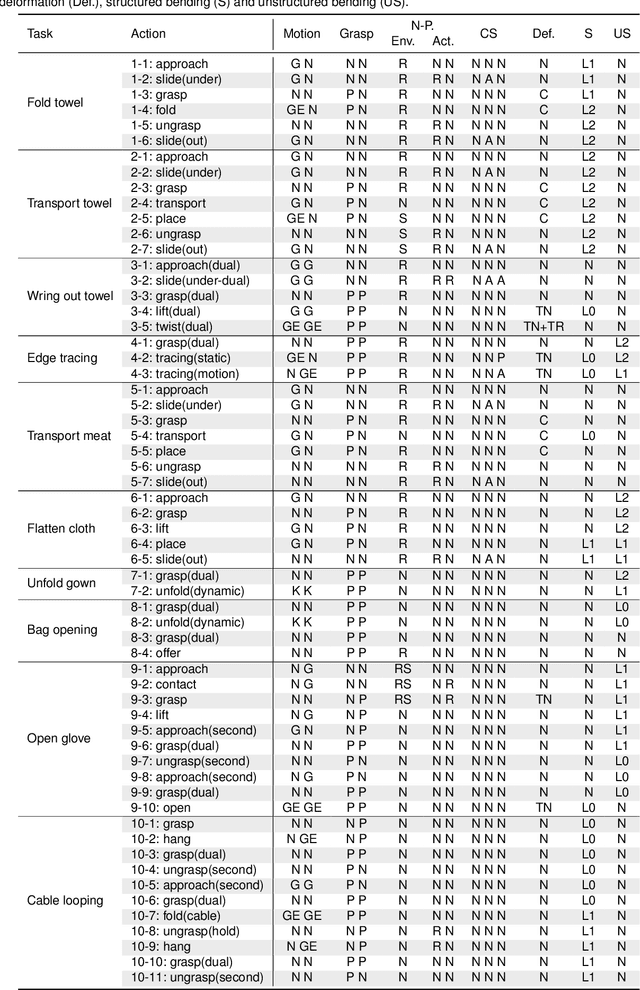Carme Torras
Beyond Static Perception: Integrating Temporal Context into VLMs for Cloth Folding
May 12, 2025Abstract:Manipulating clothes is challenging due to their complex dynamics, high deformability, and frequent self-occlusions. Garments exhibit a nearly infinite number of configurations, making explicit state representations difficult to define. In this paper, we analyze BiFold, a model that predicts language-conditioned pick-and-place actions from visual observations, while implicitly encoding garment state through end-to-end learning. To address scenarios such as crumpled garments or recovery from failed manipulations, BiFold leverages temporal context to improve state estimation. We examine the internal representations of the model and present evidence that its fine-tuning and temporal context enable effective alignment between text and image regions, as well as temporal consistency.
CloSE: A Compact Shape- and Orientation-Agnostic Cloth State Representation
Apr 07, 2025Abstract:Cloth manipulation is a difficult problem mainly because of the non-rigid nature of cloth, which makes a good representation of deformation essential. We present a new representation for the deformation-state of clothes. First, we propose the dGLI disk representation, based on topological indices computed for segments on the edges of the cloth mesh border that are arranged on a circular grid. The heat-map of the dGLI disk uncovers patterns that correspond to features of the cloth state that are consistent for different shapes, sizes of positions of the cloth, like the corners and the fold locations. We then abstract these important features from the dGLI disk onto a circle, calling it the Cloth StatE representation (CloSE). This representation is compact, continuous, and general for different shapes. Finally, we show the strengths of this representation in two relevant applications: semantic labeling and high- and low-level planning. The code, the dataset and the video can be accessed from : https://jaykamat99.github.io/close-representation
BiFold: Bimanual Cloth Folding with Language Guidance
Jan 27, 2025Abstract:Cloth folding is a complex task due to the inevitable self-occlusions of clothes, their complicated dynamics, and the disparate materials, geometries, and textures that garments can have. In this work, we learn folding actions conditioned on text commands. Translating high-level, abstract instructions into precise robotic actions requires sophisticated language understanding and manipulation capabilities. To do that, we leverage a pre-trained vision-language model and repurpose it to predict manipulation actions. Our model, BiFold, can take context into account and achieves state-of-the-art performance on an existing language-conditioned folding benchmark. Given the lack of annotated bimanual folding data, we devise a procedure to automatically parse actions of a simulated dataset and tag them with aligned text instructions. BiFold attains the best performance on our dataset and can transfer to new instructions, garments, and environments.
T-DOM: A Taxonomy for Robotic Manipulation of Deformable Objects
Dec 30, 2024



Abstract:Robotic grasp and manipulation taxonomies, inspired by observing human manipulation strategies, can provide key guidance for tasks ranging from robotic gripper design to the development of manipulation algorithms. The existing grasp and manipulation taxonomies, however, often assume object rigidity, which limits their ability to reason about the complex interactions in the robotic manipulation of deformable objects. Hence, to assist in tasks involving deformable objects, taxonomies need to capture more comprehensively the interactions inherent in deformable object manipulation. To this end, we introduce T-DOM, a taxonomy that analyses key aspects involved in the manipulation of deformable objects, such as robot motion, forces, prehensile and non-prehensile interactions and, for the first time, a detailed classification of object deformations. To evaluate T-DOM, we curate a dataset of ten tasks involving a variety of deformable objects, such as garments, ropes, and surgical gloves, as well as diverse types of deformations. We analyse the proposed tasks comparing the T-DOM taxonomy with previous well established manipulation taxonomies. Our analysis demonstrates that T-DOM can effectively distinguish between manipulation skills that were not identified in other taxonomies, across different deformable objects and manipulation actions, offering new categories to characterize a skill. The proposed taxonomy significantly extends past work, providing a more fine-grained classification that can be used to describe the robotic manipulation of deformable objects. This work establishes a foundation for advancing deformable object manipulation, bridging theoretical understanding and practical implementation in robotic systems.
Surface reconstruction of sampled textiles via Morse theory
May 27, 2024Abstract:In this work, we study the perception problem for garments using tools from computational topology: the identification of their geometry and position in space from point-cloud samples, as obtained e.g. with 3D scanners. We present a reconstruction algorithm based on a direct topological study of the sampled textile surface that allows us to obtain a cellular decomposition of it via a Morse function. No intermediate triangulation or local implicit equations are used, avoiding reconstruction-induced artifices. No a priori knowledge of the surface topology, density or regularity of the point-sample is required to run the algorithm. The results are a piecewise decomposition of the surface as a union of Morse cells (i.e. topological disks), suitable for tasks such as noise-filtering or mesh-independent reparametrization, and a cell complex of small rank determining the surface topology. This algorithm can be applied to smooth surfaces with or without boundary, embedded in an ambient space of any dimension.
Linear quadratic control of nonlinear systems with Koopman operator learning and the Nyström method
Mar 05, 2024Abstract:In this paper, we study how the Koopman operator framework can be combined with kernel methods to effectively control nonlinear dynamical systems. While kernel methods have typically large computational requirements, we show how random subspaces (Nystr\"om approximation) can be used to achieve huge computational savings while preserving accuracy. Our main technical contribution is deriving theoretical guarantees on the effect of the Nystr\"om approximation. More precisely, we study the linear quadratic regulator problem, showing that both the approximated Riccati operator and the regulator objective, for the associated solution of the optimal control problem, converge at the rate $m^{-1/2}$, where $m$ is the random subspace size. Theoretical findings are complemented by numerical experiments corroborating our results.
Towards Transferring Tactile-based Continuous Force Control Policies from Simulation to Robot
Nov 13, 2023



Abstract:The advent of tactile sensors in robotics has sparked many ideas on how robots can leverage direct contact measurements of their environment interactions to improve manipulation tasks. An important line of research in this regard is that of grasp force control, which aims to manipulate objects safely by limiting the amount of force exerted on the object. While prior works have either hand-modeled their force controllers, employed model-based approaches, or have not shown sim-to-real transfer, we propose a model-free deep reinforcement learning approach trained in simulation and then transferred to the robot without further fine-tuning. We therefore present a simulation environment that produces realistic normal forces, which we use to train continuous force control policies. An evaluation in which we compare against a baseline and perform an ablation study shows that our approach outperforms the hand-modeled baseline and that our proposed inductive bias and domain randomization facilitate sim-to-real transfer. Code, models, and supplementary videos are available on https://sites.google.com/view/rl-force-ctrl
Benchmarking the Sim-to-Real Gap in Cloth Manipulation
Oct 14, 2023Abstract:Realistic physics engines play a crucial role for learning to manipulate deformable objects such as garments in simulation. By doing so, researchers can circumvent challenges such as sensing the deformation of the object in the real-world. In spite of the extensive use of simulations for this task, few works have evaluated the reality gap between deformable object simulators and real-world data. We present a benchmark dataset to evaluate the sim-to-real gap in cloth manipulation. The dataset is collected by performing a dynamic cloth manipulation task involving contact with a rigid table. We use the dataset to evaluate the reality gap, computational time, and simulation stability of four popular deformable object simulators: MuJoCo, Bullet, Flex, and SOFA. Additionally, we discuss the benefits and drawbacks of each simulator. The benchmark dataset is open-source. Supplementary material, videos, and code, can be found at https://sites.google.com/view/cloth-sim2real-benchmark.
A novel collision model for inextensible textiles and its experimental validation
Mar 25, 2023Abstract:In this work, we introduce a collision model specifically tailored for the simulation of inextensible textiles. The model considers friction, contacts, and inextensibility constraints all at the same time without any decoupling. Self-collisions are modeled in a natural way that allows considering the thickness of cloth without introducing unwanted oscillations. The discretization of the equations of motion leads naturally to a sequence of quadratic problems with inequality and equality constraints. In order to solve these problems efficiently, we develop a novel active-set algorithm that takes into account past active constraints to accelerate the resolution of unresolved contacts. We put to a test the developed collision procedure with diverse scenarios involving static and dynamic friction, sharp objects, and complex-topology folding sequences. Finally, we perform an experimental validation of the collision model by comparing simulations with recordings of real textiles as given by a $\textit{Motion Capture System}$. The results are very accurate, having errors around 1 cm for DIN A2 textiles (42 x 59.4 cm) even in difficult scenarios involving fast and strong hits with a rigid object.
Deformable Surface Reconstruction via Riemannian Metric Preservation
Dec 22, 2022Abstract:Estimating the pose of an object from a monocular image is an inverse problem fundamental in computer vision. The ill-posed nature of this problem requires incorporating deformation priors to solve it. In practice, many materials do not perceptibly shrink or extend when manipulated, constituting a powerful and well-known prior. Mathematically, this translates to the preservation of the Riemannian metric. Neural networks offer the perfect playground to solve the surface reconstruction problem as they can approximate surfaces with arbitrary precision and allow the computation of differential geometry quantities. This paper presents an approach to inferring continuous deformable surfaces from a sequence of images, which is benchmarked against several techniques and obtains state-of-the-art performance without the need for offline training.
 Add to Chrome
Add to Chrome Add to Firefox
Add to Firefox Add to Edge
Add to Edge